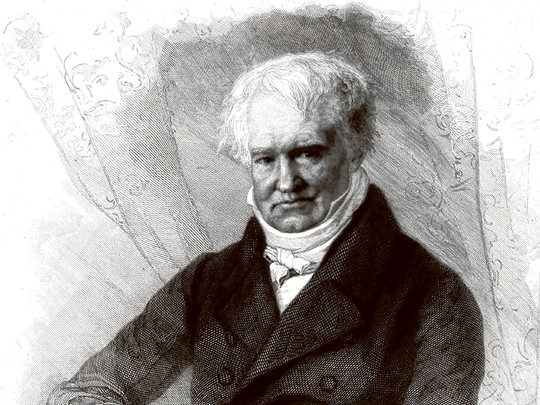
The Invention of Nature: Alexander von Humboldt’s New World
By Andrea Wulf, Knopf, 496 pages, $30
Alexander von Humboldt was the pre-eminent scientist of his time. Contemporaries spoke of him as second in fame only to Napoleon. All over the Americas and the English-speaking world, towns and rivers are still named after him, along with mountain ranges, bays, waterfalls, 300 plants and more than 100 animals. There is a Humboldt glacier, a Humboldt asteroid, a Humboldt hog-nosed skunk. Off the coast of Peru and Chile, the giant Humboldt squid swims in the Humboldt Current, and even on the moon there is an area called Mare Humboldtianum. Darwin called him the “greatest scientific traveller who ever lived.”
Yet today, outside Latin America and Humboldt’s native Germany, his name has receded into near oblivion. His insights have become so ingested by modern science that they may no longer seem astonishing. As Andrea Wulf remarks in her arresting “The Invention of Nature: Alexander von Humboldt’s New World”, “it is almost as though his ideas have become so manifest that the man behind them has disappeared.”
This formidable genius was born in 1769 to a Prussian court official and a forceful mother of Huguenot descent. He was brought up in the shadow of his precocious elder brother, Wilhelm, a linguist and philosopher, but Alexander flowered into a brilliant polymath: a slight, apparently delicate man driven by furious ambition and insecurity. People remarked on the dazzling speed and reach of his speech, on his prodigious memory — and on his waspish tongue.
As with Darwin’s voyage on the Beagle 32 years later, all of Humboldt’s work was founded on a single momentous journey, which becomes the centrepiece of Wulf’s book. In 1799, Humboldt set off for the Americas with a botanist, Aimé Bonpland, making landfall in modern Venezuela.
Together they plunged by canoe into the botanic richness of the rain forests, ascending the Upper Orinoco, where Humboldt was the first to map the great river’s union with a tributary of the Amazon — a juncture that defied contemporary assumptions.
Continuing on a nine-month, 2,100-kilometre trek along the northern Andes, the two men traversed a switchback of snow-swept passes and humid jungle, through regions unseen by any naturalist before. Scientific passion all but blinded Humboldt to danger. When an earthquake broke around him, he calmly set out his instruments to measure and time it; his experiments with electric eels might well have killed him. In the plateau lands of Peru, he discovered the magnetic equator and soon afterward studied the cold, nutrient-filled waters of the future Humboldt Current, whose rainless air parches the coasts of northern Chile and Peru.
But Humboldt’s achievement lay less in geographic discovery than in the insights that the journey sparked. Wulf, whose books include “Chasing Venus” and “Founding Gardeners: The Revolutionary Generation, Nature and the Shaping of the American Nation”, is anxious above all to establish Humboldt’s relevance today, and her fluency in German facilitates the sifting of his massive oeuvre for impressive data.
He had barely started across Venezuela before he was alerted by the falling water level in the idyllic lake of Valencia. This, he came to realise, was caused not only by the siphoning of streams for irrigation but also by the felling of the surrounding forests.
Humboldt, Wulf writes, “was the first to explain the fundamental functions of the forest for the ecosystem and climate: the trees’ ability to store water and to enrich the atmosphere with moisture, their protection of the soil, and their cooling effect. He also talked about the impact of trees on the climate through their release of oxygen. The effects of the human species’ intervention were already ‘incalculable’, Humboldt insisted, and could become catastrophic if they continued to disturb the world so ‘brutally’.”
Humboldt reached his epiphany on the slopes of Mount Chimborazo in today’s Ecuador, a mountain then considered the highest in the world. Climbing to more than 19,000 feet, he attained a mountaineering record unsurpassed for 30 years and gazed with awe at the vast landscape spread before him. Here, Wulf claims, he was struck anew by his founding conviction: that the world was a single, web-like, interconnected organism.
Later he created a complex cross-section of Chimborazo, depicting in minuscule detail the strata of its plant life. His chart related it to other mountains, stratifying phenomena such as animal species and gravity and humidity, the chemical composition of the air and the blueness of the sky. It was a pictorial diagram encapsulating his primary insight that ecosystems were universally linked. This was a view of nature — god-less and intricately whole — that would re-educate his age.
It was five years before Humboldt returned to Europe, via Cuba and Mexico. In North America, which he loved, he hobnobbed with a delighted President Thomas Jefferson. The only subject they avoided was slavery. Humboldt was revolted by its inhumanity. His detestation of colonial greed meshed with his sensitivity to environmental degradation and found its voice in two formidably researched books after his return.
In Europe, Humboldt was gloriously received. In Paris, where he settled for many years, he was lionised. In his more oppressive native Berlin, he was financially supported by successive kings. He went on to invent isotherms — the temperature lines that still flow across weather charts — and inaugurated a chain of stations across the globe to measure geomagnetism.
But above all he settled to write the monumental 34-volume account of his great journey’s findings, “Voyage to the Equinoctial Regions of the New Continent”. Part of it, the multivolume “Personal Narrative”, a travelogue that blended scientific exactitude with poetic evocation, became especially influential. Darwin wrote that the work had saturated his youth and crucially spurred his travels.
The transcendentalism in much of Humboldt’s writing deeply affected Whitman, Thoreau, Poe and the English Romantics. In South America the liberator Simón Bolívar, whom Humboldt had known in Paris, asserted that the German’s vision had awakened the South American people to pride in their continent. Later, environmentalists from George Perkins Marsh to John Muir saw Humboldt as their spiritual ancestor.
But behind the veil of celebrity, the man himself recedes. He had intense friendships with a series of young men but was self-confessedly lonely. His consolation was the beauty of nature. Mountains, he wrote enigmatically, offered him balm for the “deep wounds” that pure “reason” inflicted. (The most bitter regret of his old age was that he had never climbed the Himalayas.) The gulf between reason and emotion — the scientific study of nature and its imaginative evocation — was a gulf he healed in his writing.
Especially in Germany, there have been many Humboldts. His works are so voluminous and wide-ranging that successive regimes have extracted from them the person they desire (even, during the Third Reich, an Aryan supremacist). Andrea Wulf’s Humboldt is the ecological visionary and humanist. Despite some reiteration, her book is readable, thoughtful and widely researched, and informed by German sources richer than the English canon. It is the first formal biography in English for many years and may go some way towards returning this strange genius to the public.
He died in his 90th year, a few days after sending to the publisher the final volume of his monumental “Cosmos: A Sketch of the Physical Description of the Universe”. His science was still touched by the lyrical evocation of a holistic world. Beside him on his deathbed, mourners found a scribbled note from Genesis: “Thus the heavens and the earth were finished, and all the host of them.”
–New York Times News Service
Colin Thubron is a travel writer and novelist. His latest book is “To a Mountain in Tibet”.








